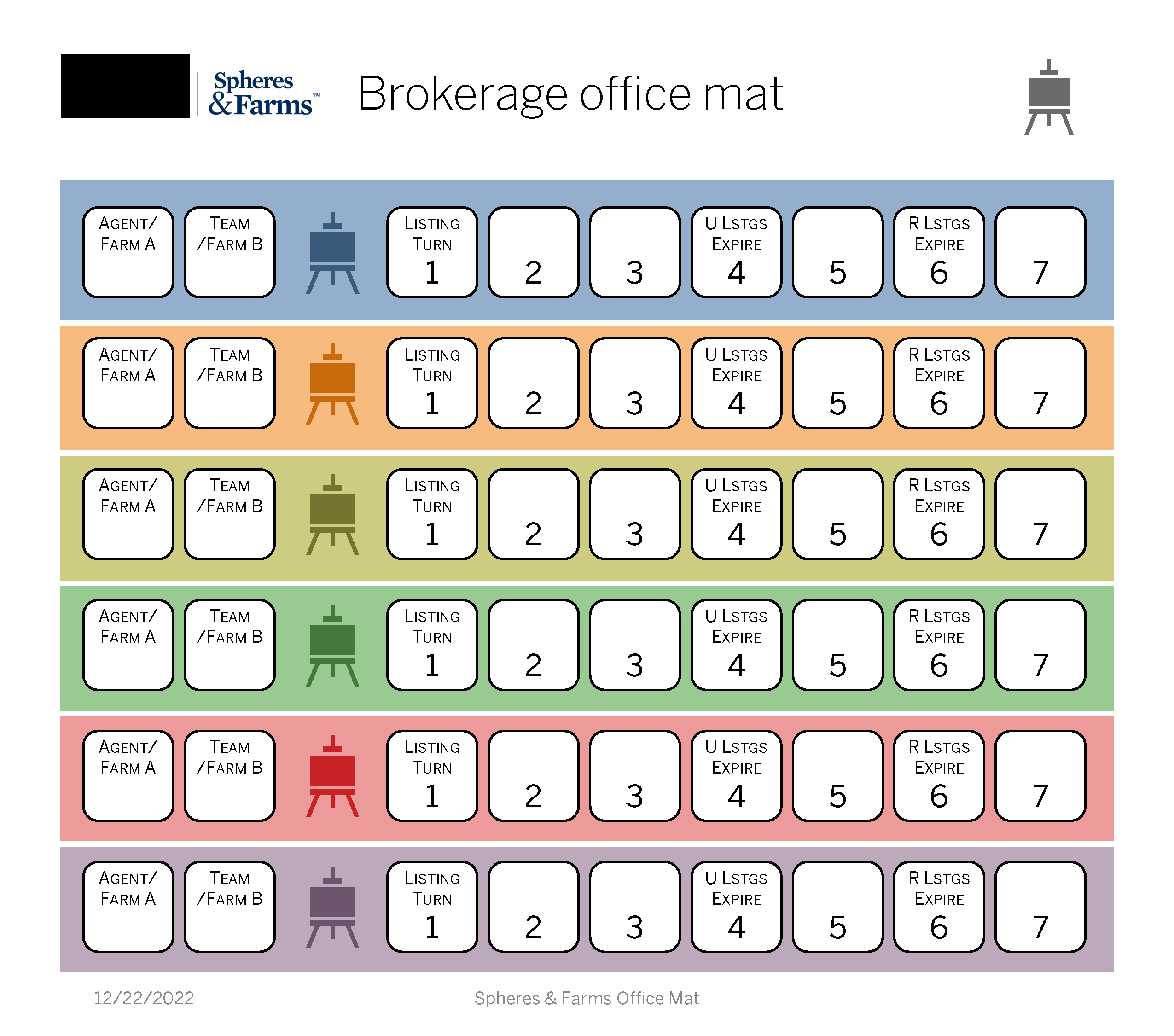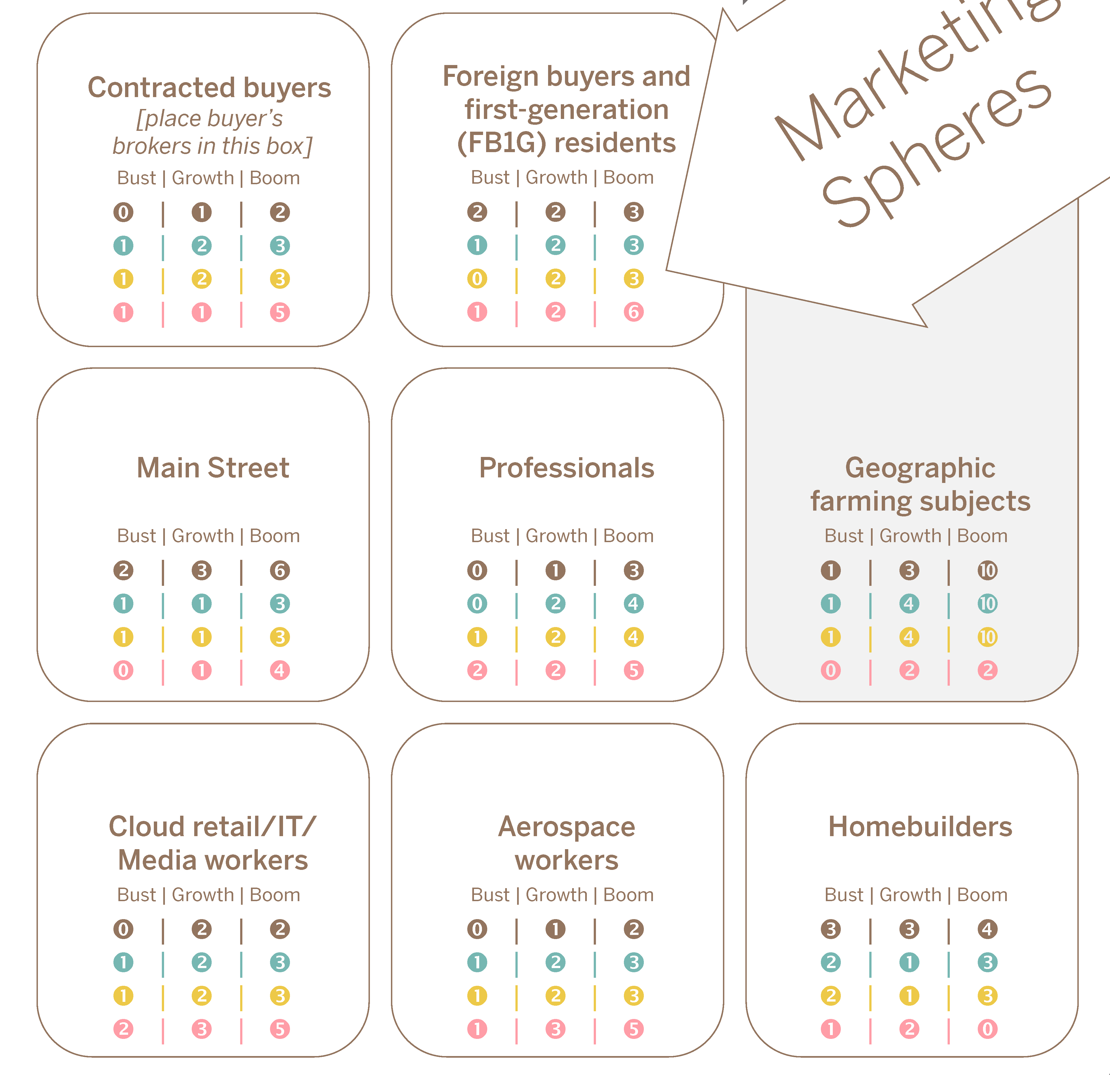[This is the eighth entry of 18 in a game design journal series introducing Spheres & Farms™, a game about real estate brokerage branding in the Puget Sound region. Previous | Next]
Geographic farming vs. sphere marketing (also called “demographic” or “niche” marketing) is the key aspect of real estate marketing that gives Spheres & Farms™ its name. These are the two basic marketing strategies of real estate agents. While a single agent can practice both simultaneously, the time investment required will often cause an agent to rely on one or the other. Spheres & Farms™ makes this explicit by requiring agents to be assigned to one method or the other. There are costs and benefits to each.
For simple reference purposes, the targets for both geographic farming and sphere marketing are precisely defined. In practice however, both exhibit fuzzy boundaries with neighboring locations or demographic categories that might be described either by rules or by data. For game purposes, it is rational enough to just assume that the boundaries of marketing spheres are strict. This would not result in realistic outcomes among the 178 locations for geographic farming, as advertising and word of mouth will draw to the prospecting agent listings in surrounding areas. Yet setting rules for each would be a mammoth task. Instead, a formula has been flexibly applied to apportion prospecting results among the target location, surrounding locations, and others further out. This method will be described in detail in the journal entry, “Visibility points: accumulation and scoring.”
Geographic farming simulates door-to-door calls, postcard mailings, local advertising, and local community involvement at these locations. Except in cases where geographic farming leads to inquiries or referrals for listings outside the area farmed, the listing opportunities resulting from geographic farming are limited by the availability and quality of properties in that area.
Sphere marketing presents no such constraints. This method of farming involves the agent capitalizing on existing relationships in a demographic network, or else upon successful insertion of himself or herself into such a network. Sphere marketing takes time to develop, but for first movers, generates more reliable returns than geographic marketing. Besides introducing the agent to a wider variety of listing opportunities, sphere marketing is more reliable during an economic downturn than geographic farming.
Market selection
Agents are not assumed to begin the game as novices. Some will be assigned at the beginning of the game. Subsequently, "new” agents will be introduced to the game or “retired” as a result of event card plays. On set up, agent markers are assigned to a brokerage mat. (Whether these are randomly assigned, or purposely assigned to some office depends upon whether offices are freely set up by players, or are assigned to certain areas as original intended.) Upon assignment of a new agent, a player receives each of the following for that agent:
- The agent’s marker for the brokerage mat
- The agent’s team marker
- The agent’s information card
- Farming and team farming markers with the brokerage mat symbol to which that agent has been assigned
- Listing counters with the symbol to which that agent has been assigned.

The player targets a market for each agent by placement of their farming markers. An agent normally has one farming marker, but may purchase a second for assignment to a geographic farm by investing some of the player’s accumulated visibility and influence points in a team. Team markers are labeled as such (with “team”). If the subject agent has just entered play, the player must select a location from among those named on the agent card.
During set-up, or in a subsequent winter turn, the player indicates that the agent is prospecting via geographic farming by placing their primary (non-team) farming marker on one of the location cards matching the starting locations shown on the agent’s information card. If the selected location is not already in play, the player draws that location card from the location card deck and places in anywhere in view on the playing surface. The agent’s information card may also indicate whether the farming markers for that agent may be immediately placed in a marketing sphere box on the sphere marketing panel (indicating an established relationship within that network). Any others must be placed on a location card as described above.

A farming marker in a marketing sphere offers access to sales that are (1) not available through geographic farming and (2) are more resistant to the economic cycle, (3) allows benefits from social media execution, (4) helps to win project unit presales, and (5) allows that agent to receive visibility and influence points related to those project sales. It also somewhat increases the risk presented on some card event plays.
Once placed, either when a new agent is deployed or later, a farm may only be moved at the end of the selling phase in a winter turn. At that time only, an agent that has achieved a threshold number of visibility and influence points13 through selling activity may immediately transfer their primary farming marker to a different market. The controlling player may move it to any adjacent location card; to any location listed on the agent’s information card; to any location where that agent has current or prior listings (keep a list for this purpose); or under some conditions, from a location card to a marketing sphere box. (An example of these conditions is the requirement that movement to the CITM or Aerospace spheres can only be of an agent with that sphere indicated on their agent card, or from a farm with the relevant employment commuting symbol.) These restrictions are because a farm, whether a geographic farm at a location, or in a marketing sphere, involves a substantial investment in relationships, advertising collateral, and image building that an agent cannot and would not be able to quickly abandon and rebuild afresh.
13 To be determined through playtesting.
Schedule of entries
- Spheres & Farms™ design and strategy journal: Introduction
- The agent and brokerage as real estate brands
- How price and place matter
- Visualization, testing, and learning
- Spheres & Farms™ game summary
- Game procedures and routines in the context of agency law and practice
- Game components; agent counters and cards
- More about marketing spheres; the economic cycle track (ECT)
- Economic cycle effects on marketing spheres
- Location cards: the Spheres & Farms™ “game map”
- Location card contents, office locations and maintenance
- The prospecting/event card deck
- Prospecting for listings and incurring events
- P&CR points: promoting and selling listings
- Construction projects and pre-sales
- Visibility points: accumulation and scoring
- Sequence of play




